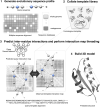Recent Advances in Protein Homology Detection Propelled by Inter-Residue Interaction Map Threading
- PMID: 34046429
- PMCID: PMC8148041
- DOI: 10.3389/fmolb.2021.643752
Recent Advances in Protein Homology Detection Propelled by Inter-Residue Interaction Map Threading
Abstract
Sequence-based protein homology detection has emerged as one of the most sensitive and accurate approaches to protein structure prediction. Despite the success, homology detection remains very challenging for weakly homologous proteins with divergent evolutionary profile. Very recently, deep neural network architectures have shown promising progress in mining the coevolutionary signal encoded in multiple sequence alignments, leading to reasonably accurate estimation of inter-residue interaction maps, which serve as a rich source of additional information for improved homology detection. Here, we summarize the latest developments in protein homology detection driven by inter-residue interaction map threading. We highlight the emerging trends in distant-homology protein threading through the alignment of predicted interaction maps at various granularities ranging from binary contact maps to finer-grained distance and orientation maps as well as their combination. We also discuss some of the current limitations and possible future avenues to further enhance the sensitivity of protein homology detection.
Keywords: homology modeling; inter-residue interaction map; protein homology; protein structure prediction; protein threading.
Copyright © 2021 Bhattacharya, Roche, Shuvo and Bhattacharya.
Conflict of interest statement
The authors declare that the research was conducted in the absence of any commercial or financial relationships that could be construed as a potential conflict of interest.
Figures


Similar articles
-
Contact-Assisted Threading in Low-Homology Protein Modeling.Methods Mol Biol. 2023;2627:41-59. doi: 10.1007/978-1-0716-2974-1_3. Methods Mol Biol. 2023. PMID: 36959441 Free PMC article.
-
DisCovER: distance- and orientation-based covariational threading for weakly homologous proteins.Proteins. 2022 Feb;90(2):579-588. doi: 10.1002/prot.26254. Epub 2021 Oct 11. Proteins. 2022. PMID: 34599831 Free PMC article.
-
Detecting distant-homology protein structures by aligning deep neural-network based contact maps.PLoS Comput Biol. 2019 Oct 17;15(10):e1007411. doi: 10.1371/journal.pcbi.1007411. eCollection 2019 Oct. PLoS Comput Biol. 2019. PMID: 31622328 Free PMC article.
-
Sequence comparison and protein structure prediction.Curr Opin Struct Biol. 2006 Jun;16(3):374-84. doi: 10.1016/j.sbi.2006.05.006. Epub 2006 May 19. Curr Opin Struct Biol. 2006. PMID: 16713709 Review.
-
Data-driven modeling and prediction of blood glucose dynamics: Machine learning applications in type 1 diabetes.Artif Intell Med. 2019 Jul;98:109-134. doi: 10.1016/j.artmed.2019.07.007. Epub 2019 Jul 26. Artif Intell Med. 2019. PMID: 31383477 Review.
Cited by
-
Insights into the structure and function of the histidine kinase ComP from Bacillus amyloliquefaciens based on molecular modeling.Biosci Rep. 2022 Oct 28;42(10):BSR20220352. doi: 10.1042/BSR20220352. Biosci Rep. 2022. PMID: 36052710 Free PMC article.
-
Evolutionary analyses of genes in Echinodermata offer insights towards the origin of metazoan phyla.Genomics. 2022 Jul;114(4):110431. doi: 10.1016/j.ygeno.2022.110431. Epub 2022 Jul 12. Genomics. 2022. PMID: 35835427 Free PMC article.
-
rrQNet: Protein contact map quality estimation by deep evolutionary reconciliation.Proteins. 2022 Dec;90(12):2023-2034. doi: 10.1002/prot.26394. Epub 2022 Jul 12. Proteins. 2022. PMID: 35751651 Free PMC article.
-
Computational and Functional Insights of Protein Misfolding in Neurodegeneration.Adv Exp Med Biol. 2023;1423:201-206. doi: 10.1007/978-3-031-31978-5_18. Adv Exp Med Biol. 2023. PMID: 37525045
-
Computational Approaches to Predict Protein-Protein Interactions in Crowded Cellular Environments.Chem Rev. 2024 Apr 10;124(7):3932-3977. doi: 10.1021/acs.chemrev.3c00550. Epub 2024 Mar 27. Chem Rev. 2024. PMID: 38535831 Free PMC article. Review.
References
-
- Abeln S., Heringa J., Anton Feenstra K. (2017). Introduction to protein structure prediction. arXiv [arXiv:1712.00407]. Available at: https://arxiv.org/abs/1712.00407v1.
Publication types
Grants and funding
LinkOut - more resources
Full Text Sources
Other Literature Sources

